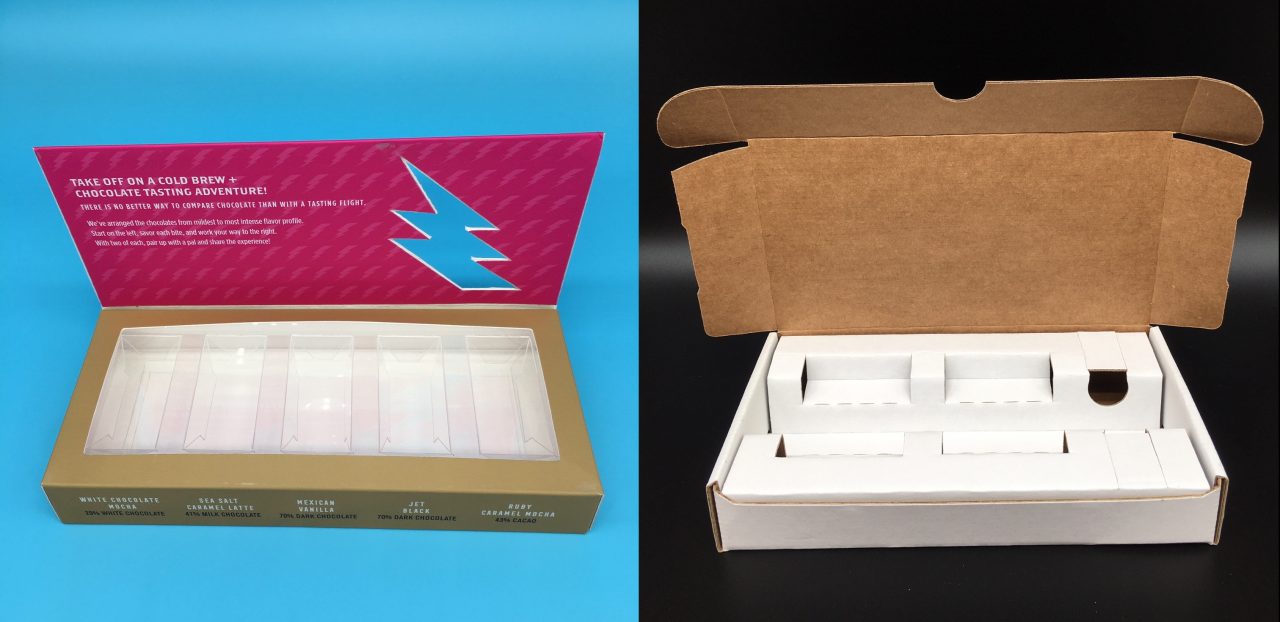Create It Packaging
Custom Packaging Inserts
When it comes to packaging your product, your carton or box is often only half the structure. Frequently, the supporting structure inside your carton is the last considerations given to packaging, but it is just as important as the box itself. If you are using a stock box, a custom printed stock box, or a completely custom box, the inserts can greatly add to your costs, so they should be accounted for at an early stage.
The use of inexpensive packing ‘filler’ materials are fine for online sales, but crumpled paper and bubble wrap will just not cut it for retail applications. Here are some examples of custom box inserts, and their relative costs.
Die Cut Board Inserts

One of the least expensive type of inserts are made from paperboard or other sheet materials. SBS board, corrugate board, acetate, and other sheet materials can be can be cut to any shape and are often cut in-line, from the same material as the package. By designing in folds, bends, and cut shapes, a functional insert can be made to securely support many products. This type of insert is cost effective for low, medium, and high runs. With thinner materials, the structure may not be suitable for all products, especially if their shape and weight lend them to being difficult to secure. As with all sheet material packaging, they will also need to be able to glued inline and lay flat during production. Tricky designs that need to be glued erected, would have to be glued by hand, raising the cost considerably.
Die Cut Foam Inserts

There are quite a variety of foam types and colors to choose from. Some foams are quite dense and rigid, while others are less dense and softer. Depending on the application, foam offer a lot of choices for protection and stylish looks as an insert choice. Foam can be CNC cut from sheets at a relatively low cost for prototype samples, and conventional die cutting is cost effective for production runs. Keep in mind, die cutting foam sheets requires cutting completely through the sheet. In order to get various levels, sheets with different cut-outs can be stacked to the total depth. Although the materials can be a higher cost than paperboard, die cut foam inserts are cost effective for low, medium, and high runs.
Green Cell Biodegradable Foam Inserts

This closed cell foam is made from corn starch, and is both biodegradable and compostable. Inserts made from this material will completely biodegrade in a moist soil environment in 4 weeks time. The foam is made in 1/4″ and 1/2″ thicknesses, and is pleated to form the desired thickness. Various layers then receive cut-outs to fit products, and are ideal for fragile items. Costs for this type of insert are good for medium to high runs. Note that no molds need to be made for their production.
Thermoformed Plastic Inserts

All molded inserts require a 3 dimensional mold in order to form. This combined with the make ready costs to begin molding prohibits their use for very short runs. Once molds are made, and high enough quantities are met to absorb the start up cost, they are cost effective solutions for securing products. Thermoformed inserts are basically a thin sheet of plastic that is heated and drawn down over a mold to conform to it’s shape. Although the insert is still a single sheet of material, it can be intricately designed to close tolerances. They are often made as a single layer tray, clam shell (folded over to protect from top and bottom), or blister, which glues to a backer card in some applications.
Molded Pulp Inserts

Molded pulp is a recycled paper product. We’ve all seen this type of product used for egg cartons, but it is also very popular for carton and box inserts. Recycled fiber from newspapers, magazines, boxes, and literally any type of waste paper product, are mixed with water, cooked, and churned into a slurry which is molded onto a sculptured form. The forms are made from metal screen, that let’s the water drain away as the fibers set to the molded shape. They are inexpensive to manufacture in large quantities, but like other molded products, the cost of the mold is prohibitive for small quantities.
Molded Styrofoam Inserts

Molded styrene foam (styrofoam) can actually be made from a variety of plastics, but is essentially an expanded plastic foam. Once cured, it can be very durable and provide a high amount of protective cushioning. These type of inserts are light in weight, and often used for expensive electronics. Molded styrofoam inserts can be made to precise dimensions, and are quite often made in two pieces (top and bottom) to secure a product from all sides. They are used to protect small items like glassware, to large items like big screen TV’s. The molds and the set up fees for this type of insert can be costly, and should only be considered for large runs.